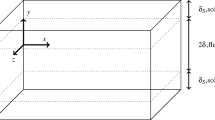Abstract
The effect of variation of the integral length scale on the accuracy of Taylor’s hypothesis and the assumption of local isotropy when a mean strain is applied to a nearly homogeneous and isotropic, heated turbulent flow is investigated. The mean strain is produced by placing one of two cylinders downstream of the heated wire mesh. Results show, the mean strain rate where the directly measured variance of the streamwise spatial gradient differs by less than ten percent from the corresponding value computed using Taylor’s hypothesis and temporal derivative decreases with increasing the ratio of the integral length scale to the cylinder diameter.
Similar content being viewed by others
Author information
Authors and Affiliations
Additional information
Received: 13 November 1997 / Accepted: 23 April 1998
Rights and permissions
About this article
Cite this article
Rahai, H., LaRue, J. Assessment of Taylor’s hypothesis and local isotropy due to strain applied to a nearly homogeneous and isotropic flow. Experiments in Fluids 26, 136–144 (1999). https://doi.org/10.1007/s003480050272
Issue Date:
DOI: https://doi.org/10.1007/s003480050272



